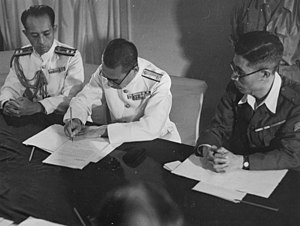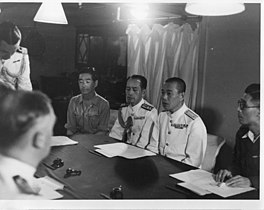Operation Jurist
| Operation Jurist | |||||||||
|---|---|---|---|---|---|---|---|---|---|
| Part of the Second World War | |||||||||
 Imperial Japanese Navy Rear Admiral Jisaku Uozumi signs the surrender of Penang aboard HMS Nelson on 2 September 1945. He fainted shortly afterwards and was rushed to hospital.[1] | |||||||||
| |||||||||
| Belligerents | |||||||||
|
|
| ||||||||
| Commanders and leaders | |||||||||
|
|
| ||||||||
| Units involved | |||||||||
|
|
| ||||||||
| Strength | |||||||||
|
42,651 infantry[3] 2 escort carriers 1 battleship 1 light cruiser 3 destroyers 3 landing craft[4] | 26,000 infantry[5] | ||||||||
| Casualties and losses | |||||||||
| None | 26,000 captured | ||||||||
Operation Jurist referred to the British recapture of Penang following Japan's surrender in 1945.[6][7][8][9] Jurist was launched as part of Operation Zipper, the overall British plan to liberate Malaya, including Singapore.
While a larger Allied fleet sailed on to Singapore through the Malacca Strait under Operation Tiderace, a detachment of Royal Navy warships, led by Vice Admiral Harold Walker, moved towards Penang Island, arriving off the island on 28 August 1945. The Japanese garrison in Penang surrendered on 2 September and a party of Royal Marine commandos landed on Penang Island the following day, thus returning Penang to British rule.
Consequently, Penang became the first state in Malaya to be liberated by the British; Singapore would only be formally surrendered to the British on 12 September, while the rest of Malaya was subsequently liberated in the following weeks.
Background
[edit]During the final phases of World War II, the Soviet Union launched an invasion of Manchuria, while the Americans were also planning a massive invasion of Japan itself. Concurrently, the British-led Southeast Asia Command, fresh from their success in reconquering Burma from Japanese hands, drew up plans to recapture Japanese-held Malaya, codenamed Operation Zipper.
The original plans had called for an amphibious assault on the western coast of Malaya by over 100,000 Allied infantry, equivalent to two divisions and a brigade, to capture Port Swettenham in Selangor and Port Dickson in Negeri Sembilan. Once the beachhead was secured and reinforced, two separate thrusts were to be accomplished—Operation Mailfist southwards to Singapore and Operation Broadsword north towards Penang.[10] The British had expected to commence Operation Zipper on 9 September 1945 and Operation Mailfist in December 1945, concluding in the liberation of Singapore by March 1946.[11]
The Americans opposed the British plans of reconquering Malaya on the grounds that such a campaign would divert a considerable amount of shipping and other resources from their planned invasion of Japan, Operation Downfall. However, the British government believed that it was necessary to liberate Singapore as soon as possible on both military and political grounds.
However, the sudden surrender of Japan in the face of Soviet conquests in Manchuria and Sakhalin Islands, and the American atomic bombings of Hiroshima and Nagasaki, forestalled all the plans.
Operation Zipper, therefore, had to be reduced in scale; while the bulk of the Allied forces would be allocated for the liberation of Singapore under Operation Tiderace, a detachment of the Royal Navy fleet and the accompanying Royal Marine commandos were tasked with the liberation of Penang instead, codenamed Operation Jurist. The liberation of Penang, which was to be carried out prior to Operation Tiderace, was intended to test Japanese intentions; up to that point, it was still unclear whether the Japanese forces in Malaya would surrender or continue resisting the Allies.[12]
Order of battle
[edit]British
[edit]The Royal Navy's Task Force 11 allocated to Operation Jurist consisted of the following ships.
| Battleship | HMS Nelson |
| Escort carriers | |
| Light cruiser | HMS Ceylon |
| Destroyers | |
| Other vessels: | 3 infantry landing ships |
-
Royal Navy destroyer HMS Petard
Vice Admiral Harold Walker, with his flagship HMS Nelson, was appointed the commander of the detachment.
In addition, Royal Marine commandos of the 3rd Brigade formed the ground forces for Operation Jurist.
Japanese
[edit]Air strength in both Malaya and Sumatra was estimated to be a little more than 170 aircraft.[13]
The Japanese Seventh Area Army, which was responsible for the defence of Malaya (including Singapore) and Borneo, included about 26,000 soldiers stationed in Malaya. Meanwhile, the port facilities in George Town, which had been used by the submarine fleets of the Axis navies, were by then heavily damaged by the repeated Allied aerial bombardment of the city.[6][14][15] The Penang Strait was also mined to impede Japanese merchant shipping passing through Penang.[16]
-
Rear Admiral Jisaku Uozomi (second from right) discussing the surrender of Penang with Vice Admiral Harold Walker aboard HMS Nelson
-
The Japanese surrender delegation boarding HMS Nelson on 2 September 1945.
Liberation of Penang
[edit]The Royal Navy's Task Force 11, carrying the Royal Marine commandos, departed Rangoon, Burma on 27 August 1945. The task force arrived off Penang Island on 28 August, met by a small fishing boat with Japanese officers on board.[7]
Initially, the Japanese officers in Penang prevaricated.[6][7] Japan's surrender had taken the Japanese high command in Singapore by surprise, with many among them unwilling to surrender and vowing to fight to the death. However, Field Marshal Count Terauchi, the commander of all Japanese forces in Southeast Asia, then ordered Japanese soldiers and servicemen in the region to lay down their arms. Things came to a head when an impatient Vice Admiral Walker issued an ultimatum for the Japanese officers stationed in Penang to sign the surrender documents on his flagship by the morning of 3 September.[7]
Eventually, the Imperial Japanese Navy Rear Admiral Jisaku Uozomi, accompanied by his officers and the Japanese Governor of Penang at the time, Lieutenant General Shinohara Seiichiro, boarded HMS Nelson on the evening on 2 September.[6][7][8][12] Inside the battleship, Vice Admiral Harold Walker, Rear Admiral Uozomi and Lieutenant General Seiichiro signed the surrender of the Japanese garrison stationed in Penang. Soon afterwards, Rear Admiral Uozomi reportedly fainted and was rushed to hospital.
In the morning of 3 September, a party of Royal Marine commandos landed at Weld Quay in George Town. After raising the Union Jack, the Royal Marines, led by a local band, marched to the Eastern & Oriental Hotel, where representatives of the Asian communities in Penang were waiting to formally hand back the city's administration to the British.
The Royal Marine detachment then spread out across George Town, encountering no resistance. Subsequent Royal Marine landing parties then took over the important military facilities on Penang Island, including the Bayan Lepas Airport and a seaplane base at Gelugor. The British commandos also confiscated Japanese military vehicles and marched the Japanese prisoners of war through the streets of George Town; the captured Japanese soldiers then surrendered their firearms before boarding the ferries to mainland Malay Peninsula, which at that point was still under Japanese jurisdiction.
By the end of the day, with the island's police force under British control, George Town became the first city in Malaya to be recaptured by the British.[6] However, hunger riots broke out across Penang Island, as years of brutal Japanese occupation took their toll on the depleted food supplies.[12]
-
Royal Marine commandos on confiscated Japanese vehicles in George Town on 3 September 1945
-
Japanese prisoners of war being marched through the streets of George Town on 3 September 1945
-
A Royal Navy officer inspecting the Japanese soldiers at the seaplane base at Gelugor
Aftermath
[edit]Penang became the first state in Malaya to be liberated by the British from Japanese rule. Over the following weeks, the rest of Malaya was gradually liberated as well. Under Operation Tiderace, the larger British and French naval force arrived off Singapore on 4 September, formally accepting the official Japanese surrender of the island on 12 September.[7][12] On 9 September, another component of Operation Zipper commenced when an amphibious assault was launched at Morib, Selangor.[12] British troops also reached Kuala Lumpur on 12 September, where the 6,000 strong Japanese garrison surrendered on the next day.
On the other hand, the British were slow at reestablishing control over all of Malaya; for instance, British forces would not reach the eastern state of Pahang for another three weeks. This allowed a growing communist insurgency to take over a number of smaller towns throughout Malaya. It was only much later in 1945 when the Malayan Communist Party's armed wing, the Malayan Peoples' Anti Japanese Army (MPAJA), agreed to surrender their weapons.
To restore order and curb the communists, all of Malaya was placed under British Military Administration beginning 12 September. British military rule would only end on 1 April 1946, whereupon it was replaced by the Malayan Union. Concurrently on 1 April 1946, the Straits Settlements was dissolved, and the now separate British crown colonies of Penang and Malacca became part of the Malayan Union.
References
[edit]- ^ "After some delay, and a failure to attend an earlier meeting, the Japanese local commander, Rear Admiral Jisaku Uzumi, came aboard HMS Nelson on the evening of 2 September, wearing the DSC he had earned as Britain's ally in the 1914-18 war, and surrendered the garrison. He fainted and was rushed to the hospital; the military policemen who carried him there took his sword as a souvenir." Bayly & Harper, page 49
- ^ Sir Harold Thomas Coulthard Walker, RN
- ^ 46 Indian Beach Group, Morib
- ^ HMS NELSON - Nelson-class 16in gun Battleship
- ^ "The real Japanese surrender" (PDF). The Sunday Times. 2005-09-04. Archived from the original (PDF) on 2008-01-19. Retrieved 2009-12-09.
- ^ a b c d e Barber, Andrew (2010). Penang At War : A History of Penang During and Between the First and Second World Wars 1914–1945. AB&B.
- ^ a b c d e f "BBC - WW2 People's War - Operation Jurist and the end of the War". www.bbc.co.uk. Retrieved 2017-03-11.
- ^ a b "JAPANESE SIGN THE SURRENDER OF PENANG ABOARD HMS NELSON (3/9/1945) | colonialfilm". www.colonialfilm.org.uk. Retrieved 2017-03-11.
- ^ Kratoska, Paul. War and Occupation in Penang, 1941–1945. Singapore: National University of Singapore.
- ^ Chant (2013)
- ^ Warren, p. 297
- ^ a b c d e Bayly; Christopher Alan, Harper, Timothy Norman (2007). Forgotten Wars: Freedom and Revolution in Southeast Asia. United States: Harvard University. ISBN 9780674021532.
{{cite book}}: CS1 maint: multiple names: authors list (link) - ^ Park, p. 2156, para 371.
- ^ Form 540 Archived 2016-03-24 at the Wayback Machine, October 1944, retrieved 8 August 2016
- ^ Thursday, 11 January 1945 - HQ AAF, retrieved 8 August 2016
- ^ Paul H. Kratoska (1998). The Japanese Occupation of Malaya: A Social and Economic History. C. Hurst & Co. Publishers. pp. 296–. ISBN 978-1-85065-284-7.
- World War II operations and battles of the Southeast Asia Theatre
- Military history of Malaya during World War II
- Battles and operations of World War II
- Battles and operations of World War II involving the United Kingdom
- 1940s in British Malaya
- British Malaya in World War II
- Military history of the British Empire and Commonwealth in World War II
- South-East Asian theatre of World War II
- South West Pacific theatre of World War II







